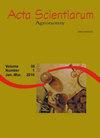Physiological quality of forage palm seeds and seedlings associated with the level of ploidy
IF 1.2
4区 农林科学
Q3 AGRONOMY
引用次数: 1
Abstract
The forage palm is widely cultivated in semiarid regions. It has a basic chromosome number of x = 11 and polyploids are the main variation. It is propagated via vegetative reproduction, and sexual propagation is rarely used. The objective was to associate the physiological quality of seeds of different cultivars of forage palm with the level of ploidy in the genera Opuntia and Nopalea. The cultivars used were: diploids (2n = 22) ‘F8’, ‘F21’, and ‘IPA Sertânia’; tetraploids (2n = 44) ‘Clone 6 African Elephant Ear’, ‘Mexican Elephant Ear’, and ‘V19’, and octaploids (2n = 88) ‘Round’, ‘Giant’, and ‘IPA Clone 20’. Thousand seed weight, length, diameter, number of seeds per fruit, first count and emergence percentage, shoot and root length, fresh and dry mass, electrical conductivity, and length, width, and fresh and dry weight of cladodes were measured. A nested scheme design was used, with three levels of ploidy and three cultivars within each level. The ploidy level positively influenced the number of seeds per fruit and the physiological quality of the seeds. Cultivars behave differently within the same ploidy level.饲用棕榈种子和幼苗的生理品质与倍性水平有关
草料棕榈在半干旱地区广泛种植。它的基本染色体数为x = 11,多倍体是主要的变异。它通过营养繁殖繁殖,有性繁殖很少使用。目的是将不同饲用棕榈品种种子的生理品质与Opuntia属和Nopalea属的倍性水平联系起来。使用的品种有:二倍体(2n = 22)‘F8’、‘F21’和‘IPA sertnnia’;四倍体(2n = 44)“克隆6号非洲象耳”、“墨西哥象耳”和“V19”,以及八倍体(2n = 88)“圆形”、“巨型”和“IPA克隆20”。测定千粒重、长度、直径、单果种子数、首粒数和出苗率、茎长和根长、鲜干质量、电导率、枝长、宽度和鲜干质量。采用巢式设计,将倍性设为3个水平,每个水平设3个品种。倍性水平正影响单果种子数和种子生理品质。在相同的倍性水平内,不同的品种表现不同。
本文章由计算机程序翻译,如有差异,请以英文原文为准。
求助全文
约1分钟内获得全文
求助全文
来源期刊

Acta Scientiarum. Agronomy.
Agricultural and Biological Sciences-Agronomy and Crop Science
CiteScore
2.40
自引率
0.00%
发文量
45
审稿时长
>12 weeks
期刊介绍:
The journal publishes original articles in all areas of Agronomy, including soil sciences, agricultural entomology, soil fertility and manuring, soil physics, physiology of cultivated plants, phytopathology, phyto-health, phytotechny, genesis, morphology and soil classification, management and conservation of soil, integrated management of plant pests, vegetal improvement, agricultural microbiology, agricultural parasitology, production and processing of seeds.
 求助内容:
求助内容: 应助结果提醒方式:
应助结果提醒方式:


